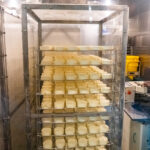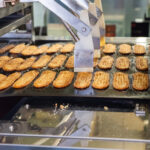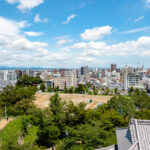This post may contain affiliate links. Please read our disclosure policy.
Hikari Miso’s Factory in Nagano Prefecture shows how soybeans, rice, and spring water become one of Japan’s most beloved ingredients.

Hikari Miso’s Iijima Green Factory
Nestled at the base of the Central Alps, the Iijima Green Factory produces some of the finest miso in Japan. The factory uses pure spring water from snowmelt, giving its miso a clean and rich flavor. Surrounded by rice fields and mountains, the location highlights the strong link between Japanese food and its natural environment.
Since 2009, the factory has also focused on sustainability by capturing methane gas from its wastewater to generate power for its operations.
What Is Miso and How Is It Made?

Miso is made from soybeans, rice koji, salt, and water. The mixture ferments and ages, creating umami through natural enzymes. By adjusting the type of soybeans, koji, and salt, Hikari Miso produces a wide range of flavors, from mild and sweet to bold and earthy.
Inside the Factory: The Miso-Making Process

We suited up in clean gear before stepping inside the production area. Here’s how the process unfolds:
Step 1: Prepping the Ingredients
- Soybeans: Stored in massive silos, sorted, soaked, and steamed. Organic beans are kept separately.
- Rice: Steamed and mixed with koji mold to create rice koji.
- Salt: Added in large quantities, sometimes up to 1,000 kg.
Step 2: Cooking and Mixing

One of the largest koji-making machines in Japan, capable of handling 34 tons, carefully controls the process. Cooked soybeans are ground, then combined with rice koji and salt.
Step 3: Fermentation

The mixture is transferred to giant stainless steel tanks inside a warehouse the size of a football field. Fermentation time varies depending on the miso style.
Step 4: Packaging

We watched tubs, pouches, and instant miso soup products move along automated packaging lines. It was impressive to see the variety of miso produced here, all destined for kitchens in Japan and abroad.
Why We Enjoy Visiting Food Factories

We’ve toured soy sauce breweries, mochi shops, and seafood producers across Japan, and each visit gives our kids a chance to see where their food comes from and the effort behind it. At Hikari Miso, watching traditional methods blend with large-scale production gave us a new respect for this everyday seasoning.
Our visit showed how a simple mix of soybeans, rice, and salt is transformed into one of the cornerstones of Japanese cooking. It was both educational and inspiring, and it left us with an even greater appreciation for miso in our daily meals.
Please Note: The Iijima Green Factory isn’t open for standard tours.
More to Explore Nearby
If you’re in Nagano Prefecture, there are plenty of other attractions worth visiting:
- Lake Suwa (諏訪湖) – A scenic lake with hot springs, shrines, and seasonal festivals.
- Matsumoto Castle (松本城) – One of Japan’s original castles, famous for its black exterior.
- Kiso Valley (木曽谷) – Historic post towns like Magome and Tsumago along the old Nakasendo trail.
- Daio Wasabi Farm (大王わさび農場) – Japan’s largest wasabi farm, with fields, watermills, and fresh wasabi dishes




